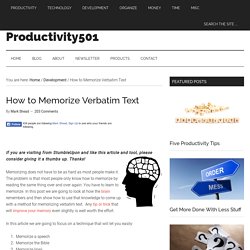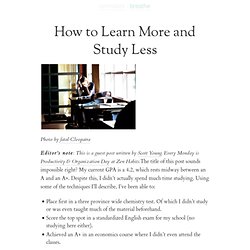

What are the Intellectual Ideas Everybody Should Know? How to Memorize - Learn to memorize and increase memory. If you are visiting from StumbleUpon and like this article and tool, please consider giving it a thumbs up.

Thanks! Memorizing does not have to be as hard as most people make it. The problem is that most people only know how to memorize by reading the same thing over and over again. You have to learn to memorize. In this post we are going to look at how the brain remembers and then show how to use that knowledge to come up with a method for memorizing verbatim text. 10 Tips to Study Smart and Save Time. I recently got my marks back from University.

My grade point average was a 4.2 out of a possible 4.5, resting between an A and a perfect A+. In itself, this isn’t an incredible achievement. But I managed to do this while spending only a fraction of the time studying than many of the people I knew. How to Learn More and Study Less. Photo by fatal Cleopatra Editor’s note: This is a guest post written by Scott Young.

Every Monday is Productivity & Organization Day at Zen Habits.The title of this post sounds impossible right? My current GPA is a 4.2, which rests midway between an A and an A+. Despite this, I didn’t actually spend much time studying. Using some of the techniques I’ll describe, I’ve been able to: Place first in a three province wide chemistry test. I say all this not to boast about how great I am, because I feel my accomplishments are rather modest compared to many people I know.
More studying time won’t help if the way you are studying is flawed to begin with. Holistic Learning Smart people don’t just learn better. Holistic learning is basically the opposite of rote memorization. How to retain 90% of everything you learn. Imagine if you had a bucket of water.

And every time you attempted to fill the bucket, 90% of the water would leak out instantly. Every time, all you’d retain was a measly 10%. How many times would you keep filling the bucket? The answer is simple: just once. The first time you noticed the leak, you’d take action You’d either fix the bucket or you’d get another bucket, wouldn’t you?
Yet that’s not at all the way we learn. That weird thing is that you’re wasting time. To summarize the numbers (which sometimes get cited differently) learners retain approximately: 90% of what they learn when they teach someone else/use immediately. 75% of what they learn when they practice what they learned. 50% of what they learn when engaged in a group discussion. 30% of what they learn when they see a demonstration. 20% of what they learn from audio-visual. 10% of what they learn when they’ve learned from reading. 5% of what they learn when they’ve learned from lecture. Einstein’s Secret to Amazing Problem Solving (and 10 Specific Ways You Can Use It) Einstein is quoted as having said that if he had one hour to save the world he would spend fifty-five minutes defining the problem and only five minutes finding the solution.
This quote does illustrate an important point: before jumping right into solving a problem, we should step back and invest time and effort to improve our understanding of it. Here are 10 strategies you can use to see problems from many different perspectives and master what is the most important step in problem solving: clearly defining the problem in the first place! The Problem Is To Know What the Problem Is The definition of the problem will be the focal point of all your problem-solving efforts. As such, it makes sense to devote as much attention and dedication to problem definition as possible. Problem Definition Tools and Strategies The good news is that getting different perspectives and angles in order to clearly define a problem is a skill that can be learned and developed.
Creative Problem Solving with SCAMPER. SCAMPER is a technique you can use to spark your creativity and help you overcome any challenge you may be facing. In essence, SCAMPER is a general-purpose checklist with idea-spurring questions — which is both easy to use and surprisingly powerful. It was created by Bob Eberle in the early 70s, and it definitely stood the test of time. In this posting, I present a complete SCAMPER primer, along with two free creativity-boosting resources: a downloadable reference mind map and an online tool that generates random questions to get you out of a rut whenever you need. SCAMPER Primer SCAMPER is based on the notion that everything new is a modification of something that already exists.
S = SubstituteC = CombineA = AdaptM = MagnifyP = Put to Other UsesE = Eliminate (or Minify)R = Rearrange (or Reverse) To use the SCAMPER technique, first state the problem you’d like to solve or the idea you’d like to develop. Consider, for instance, the problem "How can I increase sales in my business? " Combine. How to Become an Expert: A Roadmap. Wouldn’t you like to be an expert?

To intuitively know the right answers? Enter the Dreyfus model of skill acquisition, which shines a light on how we develop and master skills, helping us understand how we progress from novice to expert, including all the steps in between. Experts are Not Just Supercharged Novices.